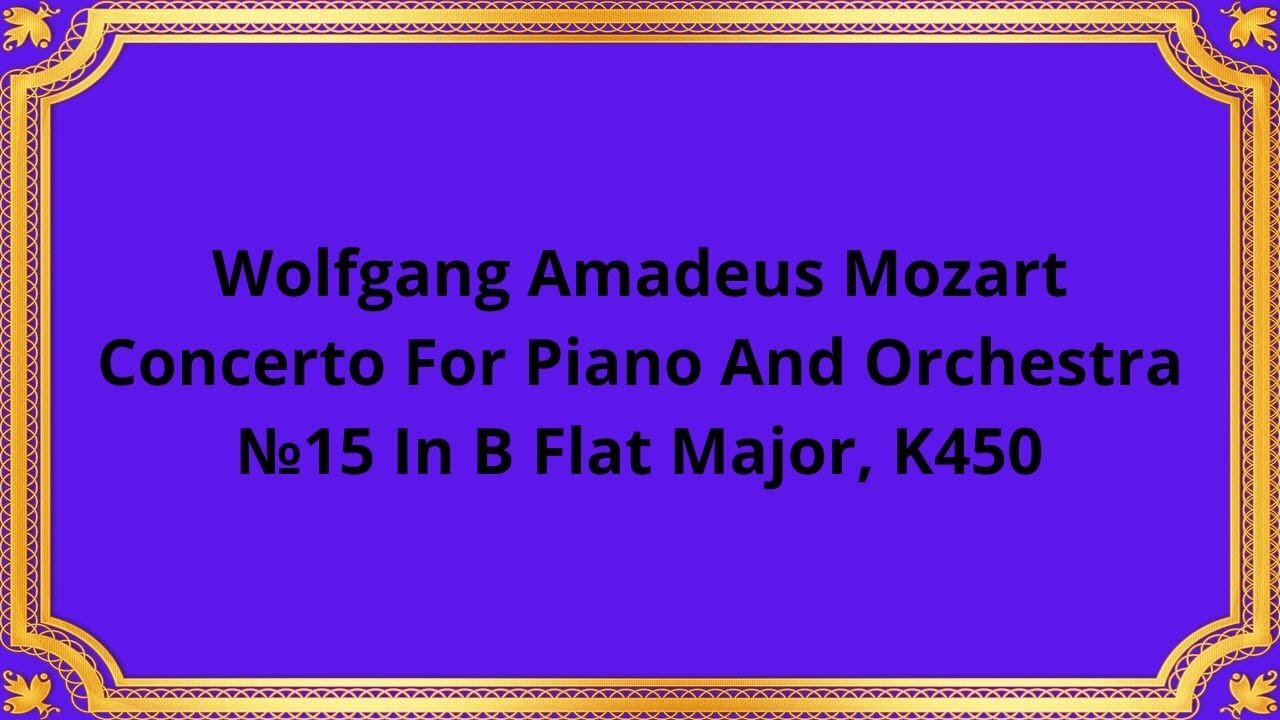Premium Only Content

Wolfgang Amadeus Mozart Concerto For Piano And Orchestra №15 In B Flat Major, K450
#WolfgangAmadeusMozart #ConcertoForPianoandOrchestra #No15 #BFlatMajor #K450 #ClassicalMusic #MusicalComposition #MozartConcerto #ClassicalComposer #ClassicalEra #ClassicalPiano
Publication date 1961
PRO MUSICA ORCHESTRA, VIENNA
Ingrid Haebler — Conductor: Heinrich Hollreiser
Wolfgang Amadeus Mozart, a name synonymous with brilliance in classical music, has gifted the world with countless masterpieces. Among his remarkable compositions, the Concerto for Piano and Orchestra No. 15 in B Flat Major, K450, stands as a testament to his musical genius.
Composed in 1784, Mozart's Concerto for Piano and Orchestra No. 15 represents the pinnacle of the Classical era. This period celebrated a shift from the Baroque style towards a more balanced and refined approach to music. Mozart was at the forefront of this movement, and this concerto exemplifies his mastery of the genre.
The concerto follows the traditional three-movement structure: Allegro, Andante, and Allegro. The first movement, marked Allegro, introduces the exuberant and lively character of the concerto. It begins with a vibrant orchestral introduction, paving the way for the solo piano to shine. Mozart's exceptional gift for melody is showcased through the interplay between the piano and the orchestra, creating a harmonious and captivating musical dialogue.
The second movement, Andante, contrasts the vivacity of the first movement with a serene and introspective atmosphere. Here, Mozart displays his ability to evoke deep emotions through his music. The piano takes center stage, weaving delicate and expressive melodies, while the orchestra provides a gentle accompaniment. The result is a mesmerizing and introspective musical journey.
The final movement, marked Allegro, brings back the energy and liveliness of the concerto. It is characterized by its playful and spirited nature, with rapid passages, virtuosic piano solos, and delightful interactions between the piano and the orchestra. Mozart's exceptional compositional skills shine through the intricate harmonies and dynamic contrasts, leaving the listener in awe of his brilliance.
Mozart's Concerto for Piano and Orchestra No. 15 is characterized by its technical brilliance, melodic richness, and inventive orchestration. The solo piano part showcases virtuosic passages, demanding precision and dexterity from the pianist. Mozart's ability to seamlessly intertwine the piano and the orchestra creates a harmonious and balanced sound, highlighting his mastery of both composition and orchestration.
Another notable feature of this concerto is Mozart's use of cadenzas. These are moments within the concerto where the soloist has the opportunity to improvise and display their own musical interpretation. These cadenzas add a personal touch to each performance, allowing the pianist to showcase their own creativity and virtuosity.
Conclusion:
Wolfgang Amadeus Mozart's Concerto for Piano and Orchestra No. 15 in B Flat Major, K450, is a testament to his musical genius and enduring legacy. Its historical significance, impeccable structure, and notable features continue to captivate audiences to this day. Through this concerto, Mozart's unparalleled talent and creativity shine, reminding us of the timeless beauty and power of classical music.
You have the opportunity to support the channel:
https://destream.net/live/RadSiarAl/donate
https://www.buymeacoffee.com/6355radsiaral
-
 14:44
14:44
Classical music_Music Inspiration
1 month agoLudwig van Beethoven Sonata No. 14 in C-Sharp Minor, Op. 27, No. 2 "Moonlight"
63 -
 2:10:41
2:10:41
Adam Carolla
1 day agoCatalytic Converter Theft Turns Deadly + UPDATE! Rebuilding Malibu | Adam’s Wild Malibu Trip
5.58K6 -
 47:43
47:43
Russell Brand
6 hours agoWho’s Controlling the Narrative? Iran, Epstein, and the Fight Over Women’s Sports – SF552
119K77 -
 1:54:25
1:54:25
vivafrei
6 hours agoCanadian Premiers BUCKLE! "Gender" Wars in Congress! Madness in Seattle AND MORE! Viva Frei Live
75.1K79 -
 1:58:28
1:58:28
The Charlie Kirk Show
4 hours agoWhy The Left Hates Musk + Punishing Campus Antisemitism | Terrell | 3.12.25
87.3K21 -
 1:33:23
1:33:23
Simply Bitcoin
5 hours ago $3.15 earnedPlan To Buy 1M Bitcoin is BACK With A HUGE TWIST!! | EP 1201
52.6K1 -
 56:47
56:47
The Dan Bongino Show
7 hours agoSpending Bill Passes House And Everyone Loses Their Mind (Ep. 2440) - 03/12/2025
622K1.44K -
 3:43:02
3:43:02
Right Side Broadcasting Network
7 hours agoLIVE REPLAY: President Trump Holds a Meeting with the Taoiseach of Ireland - 3/12/25
118K15 -
 1:03:27
1:03:27
The Rubin Report
6 hours agoThe Exact Moment Bernie Has His Socialist Dream Crushed Into Dust
91.9K48 -
 1:56:59
1:56:59
Steven Crowder
7 hours agoTrump Keeps Winning | Rosie Flees, Ukraine Ceasefire Deal, Canada Backs Down & So Much More
482K324